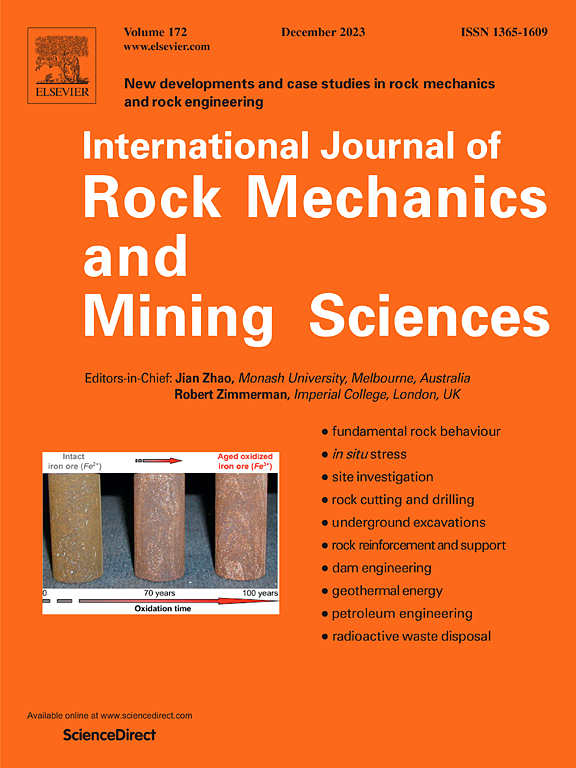A parameterized model reconstruction method for multi-mineral porous rocks
IF 7.5
1区 工程技术
Q1 ENGINEERING, GEOLOGICAL
International Journal of Rock Mechanics and Mining Sciences
Pub Date : 2025-06-12
DOI:10.1016/j.ijrmms.2025.106162
引用次数: 0
Abstract
Rocks, composed of various minerals and defects, exhibit complex deformation and failure processes. Traditional analytical methods and homogenized medium-based models struggle to address such complexity. Developing a numerical model that closely mimics the structure of real rocks rather than only a replication of rock structure is a critical challenge. To address this, this work proposes a parameterized model reconstruction method for generating multi-mineral porous rock models based on rock images. The basic principle of the method is as follows: first, rock minerals and pores are differentiated through grayscale image analysis; then, the optimal ellipse for each pore or mineral grain is fitted based on its boundary; the relationship between the grains and their optimal ellipses is analyzed, and the boundary features are quantified using ellipse parameters; finally, non-regular pores or grains are generated through inversion, ultimately rebuilding a multi-mineral porous rock model that has same mineral content and structural characteristics to the real rock. The proposed method offers several key advantages: realistic replication of pore and mineral shapes, precise control over porosity and mineral content, support for parametric studies, scalability for large models, directional alignment of mineral grains, and broad applicability. To validate the method, various materials were used, including the generation of models with regular and irregular pores, contacting and non-contacting pores, multi-mineral rocks, and directionally arranged mineral grains. The results demonstrate that the proposed method has unique advantages in generating these materials. Finally, the method was applied to preliminary studies in rock wave propagation, uniaxial compression, and ultra-low temperature damage by using a distinct lattice spring model, highlighting its significant potential for both scientific research and engineering applications. The program code can be made available to researchers with reasonable request.
多矿物多孔岩参数化模型重建方法
岩石由各种矿物和缺陷组成,表现出复杂的变形和破坏过程。传统的分析方法和同质化的基于媒介的模型难以处理这种复杂性。开发一种接近真实岩石结构的数值模型,而不仅仅是岩石结构的复制,是一项关键的挑战。针对这一问题,本文提出了一种基于岩石图像生成多矿物多孔岩石模型的参数化模型重建方法。该方法的基本原理是:首先,通过灰度图像分析区分岩石矿物和孔隙;然后,根据孔隙或矿物颗粒的边界拟合出其最优椭圆;分析了晶粒与其最优椭圆的关系,利用椭圆参数对边界特征进行了量化;最后通过反演生成不规则孔隙或颗粒,最终重建出与真实岩石具有相同矿物含量和结构特征的多矿物多孔岩石模型。所提出的方法具有几个关键优势:真实地复制孔隙和矿物形状,精确控制孔隙度和矿物含量,支持参数研究,大型模型的可扩展性,矿物颗粒的定向排列以及广泛的适用性。为了验证该方法,我们使用了不同的材料,包括生成规则孔隙和不规则孔隙、接触孔隙和非接触孔隙、多矿物岩石和矿物颗粒定向排列的模型。结果表明,该方法在制备这些材料方面具有独特的优势。最后,将该方法应用于岩波传播、单轴压缩和超低温损伤的初步研究中,通过使用不同的晶格弹簧模型,突出了其在科学研究和工程应用方面的巨大潜力。程序代码可以提供给研究人员合理的要求。
本文章由计算机程序翻译,如有差异,请以英文原文为准。
求助全文
约1分钟内获得全文
求助全文
来源期刊
CiteScore
14.00
自引率
5.60%
发文量
196
审稿时长
18 weeks
期刊介绍:
The International Journal of Rock Mechanics and Mining Sciences focuses on original research, new developments, site measurements, and case studies within the fields of rock mechanics and rock engineering. Serving as an international platform, it showcases high-quality papers addressing rock mechanics and the application of its principles and techniques in mining and civil engineering projects situated on or within rock masses. These projects encompass a wide range, including slopes, open-pit mines, quarries, shafts, tunnels, caverns, underground mines, metro systems, dams, hydro-electric stations, geothermal energy, petroleum engineering, and radioactive waste disposal. The journal welcomes submissions on various topics, with particular interest in theoretical advancements, analytical and numerical methods, rock testing, site investigation, and case studies.

 求助内容:
求助内容: 应助结果提醒方式:
应助结果提醒方式:


